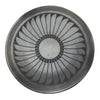
Julian Martinez (1885-1943) Biography
Julian Martinez Pocano, known as Coming of the Spirits, had no formal art training. He is best known for his designs he painted on pottery that his wife, Maria, shaped. He also painted gouache on paper paintings since 1920. He received several commissions for murals, which are shown at the School of American Research in Santa Fe, the Santa Fe Indian School, and the Mesa Verde National Park in Colorado.
Julian and Maria refined their pottery techniques and were asked to demonstrate their craft at several expositions, including the 1904 St. Louis World's Fair, the 1914 Panama-California Exposition in San Diego, and the 1934 Chicago World's Fair. Part of their success came from their innovations in the style of black-on-black ware.
Although other pueblos, such as Santa Clara, had been producing black wares, Julian and Maria invented a technique that would allow for areas of the pottery to have a matte finish and other areas to be a glossy jet black. Through experimentation that began in 1919, they created a style that would become world famous.
Julian replicated and was inspired by many pre-historic designs. He was fond of many motifs, using ancient symbols in new combinations. He often painted the avanyu, the horned water serpent, which he saw as a symbol for the rush of water after a hard rain, and as a metaphor for the pueblo itself.
For many years, Julian and Maria produced their pottery together amid raising a family and carrying out traditional duties for the pueblo. Their children were taught the importance of the craft, and they participated in various ways. Julian Martinez became governor of San Ildefonso in 1925.
From 1925 until his death in 1943, Maria and Julian shared their signatures on their pottery as “Marie & Julian.” Julian died on March 6, 1943 in San Ildefonso pueblo. He was the father of Popovi Da, also a well known pueblo potter and painter.